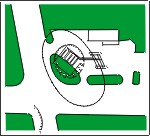EPA On-line Tools for Site Assessment Calculation
Dispersivity
| Using the gradient scaled from a map calculator, I checked distances on the plans showing the water levels and extent of contamination. We'll use the gradient calculator to get a distance from the map and then use the dispersivity calculator to get the dispersivity. It was easier for me to use a paper copy of the plans, than to scale them off the computer screen. My results: |

|
| Quantity |
Value |
| Map scale |
1.25 inches = 60 feet |
| Plume length |
4 inches |
|
|

|
First we need the plume length. The gradient calculator can be used to scale distances off a map. Here we have a distance of 4 inches at a scale of 1 1/4 inches equals 60 feet. |
|
|

|
So for the dispersivity the question again is: "Is the value used in the report reasonable?" The value used was 18.7 feet. Dispersivities are rarely measured in the field (for UST sites "rarely" is a euphemism for never), but rather dispersivities are either treated as calibration parameters or set from what I call data-based "rules of thumb." The oldest rule of thumb that apparently goes back to a paper by Pickens and Grisak, 1981 is that the longitudinal dispersivity is one tenth the plume length. The dispersivity calculator has improved rules of thumb, so check value of dispersivity for the plume length of 192 feet. |
|
|


